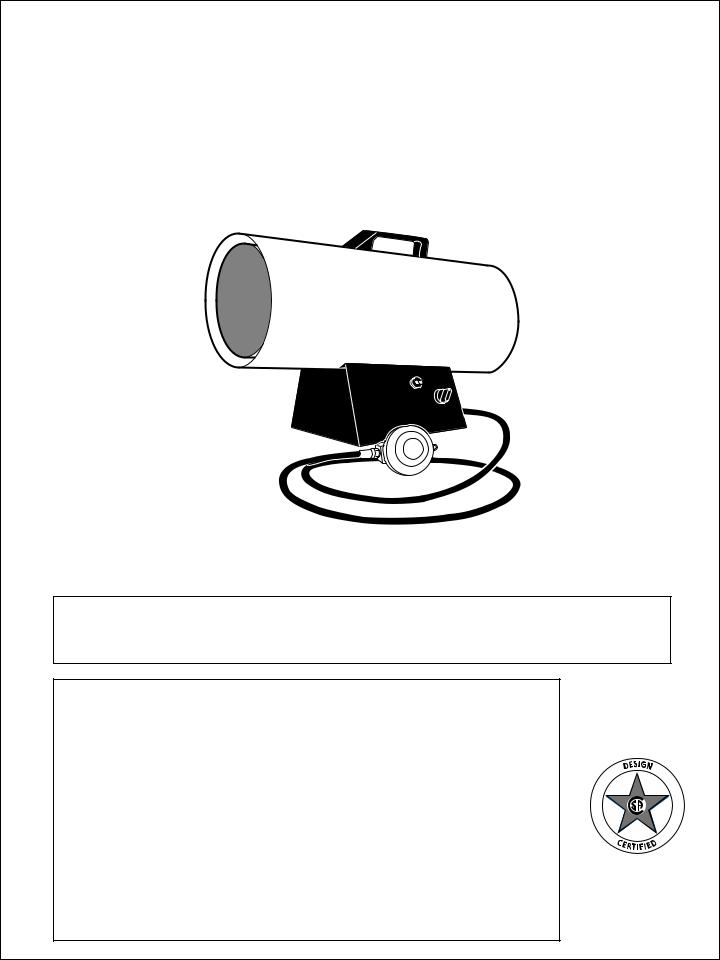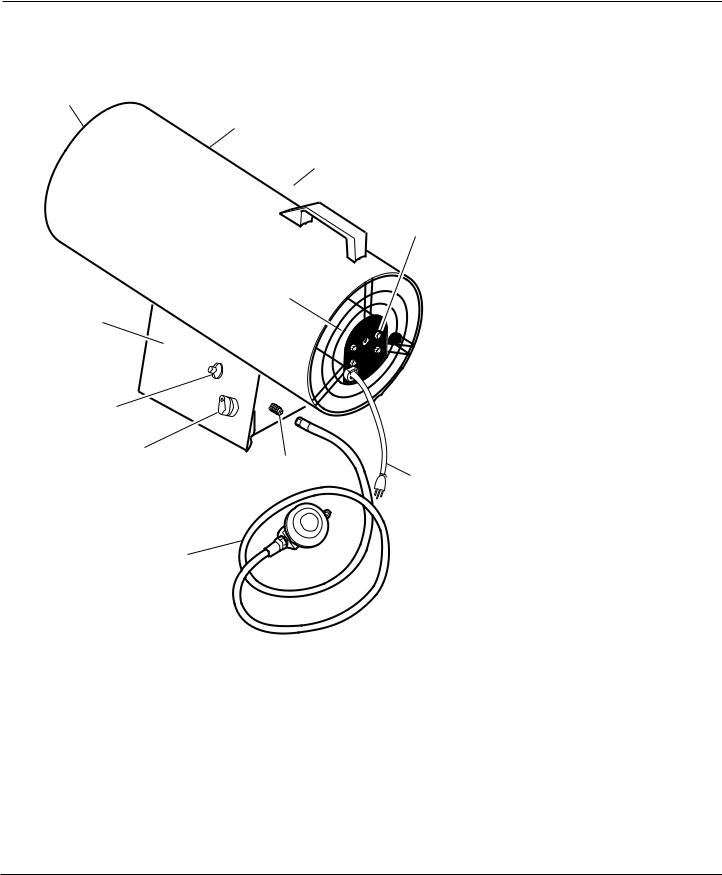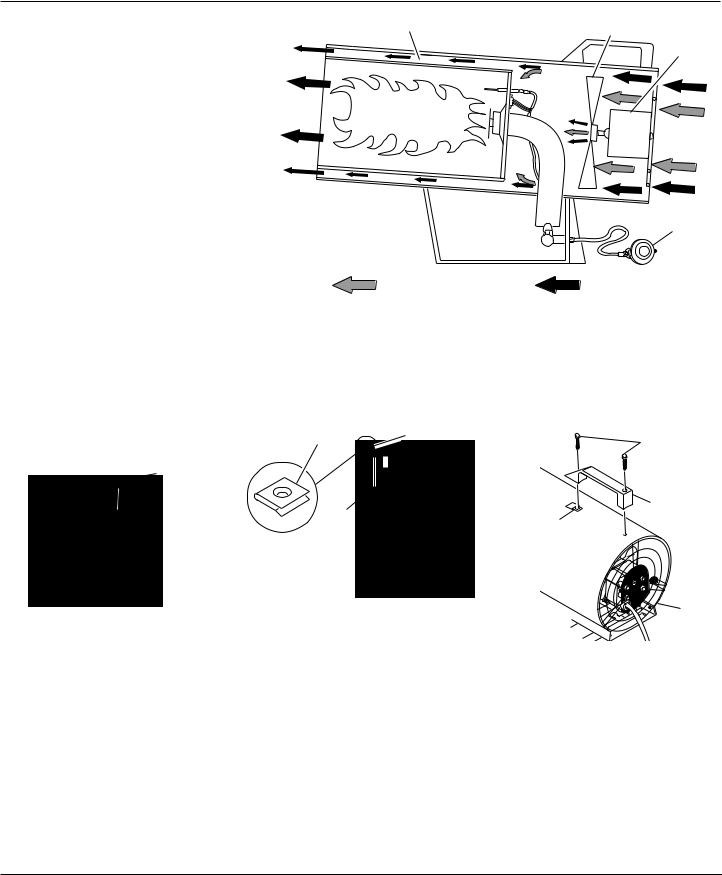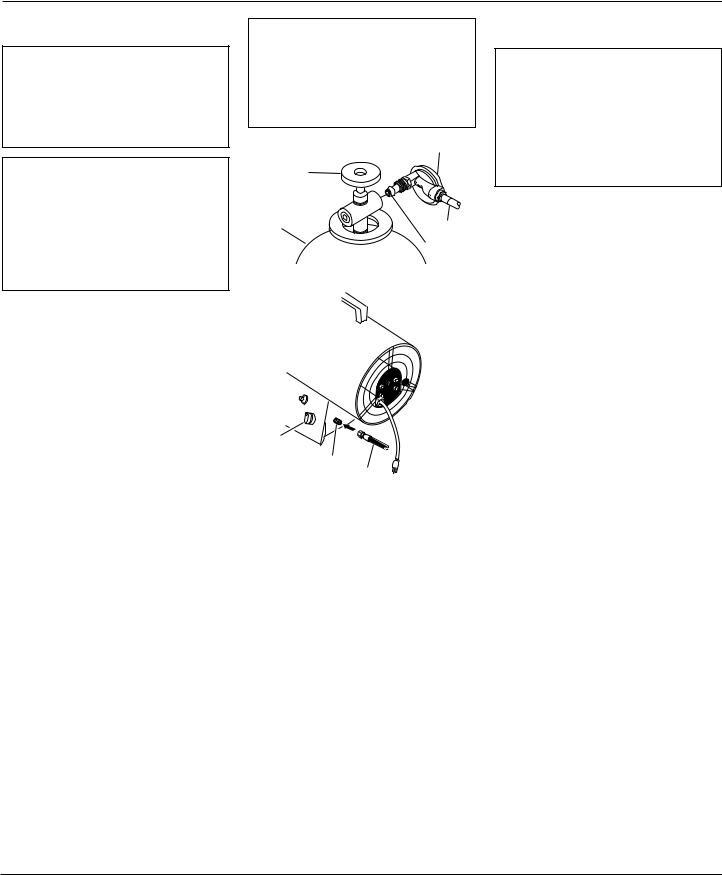Desa RLP50VA, REM50PVA, BLP50VA User Manual

PROPANE
CONSTRUCTION
HEATER
OWNER’S MANUAL
Models: RLP50VA, BLP50VA, and REM50PVA
IMPORTANT: Read and understand this manual before assembling, starting, or servicing heater. Improper use of heater can cause serious injury. Keep this manual for future reference.
 GENERAL HAZARD WARNING: FAILURE TO COMPLY WITH THE PRECAUTIONS AND INSTRUCTIONS PROVIDED WITH THIS HEATER, CAN RESULT IN DEATH, SERIOUS BODILY INJURY AND PROPERTY LOSS OR DAMAGE FROM HAZARDS OF FIRE, EXPLOSION, BURN, ASPHYXIATION, CARBON MONOXIDE POISONING, AND/OR ELECTRICAL SHOCK.
GENERAL HAZARD WARNING: FAILURE TO COMPLY WITH THE PRECAUTIONS AND INSTRUCTIONS PROVIDED WITH THIS HEATER, CAN RESULT IN DEATH, SERIOUS BODILY INJURY AND PROPERTY LOSS OR DAMAGE FROM HAZARDS OF FIRE, EXPLOSION, BURN, ASPHYXIATION, CARBON MONOXIDE POISONING, AND/OR ELECTRICAL SHOCK.
ONLY PERSONS WHO CAN UNDERSTAND AND FOLLOW THE INSTRUCTIONS SHOULD USE OR SERVICE THIS HEATER.
IF YOU NEED ASSISTANCE OR HEATER INFORMATION SUCH AS AN INSTRUCTIONS MANUAL, LABELS, ETC. CONTACT THE MANUFACTURER.

50,000 BTU/HR
PROPANE CONSTRUCTION HEATER
SAFETY
INFORMATION
 WARNINGS
WARNINGS
 WARNING: FIRE, BURN, INHALATION, AND EXPLOSION HAZARD. KEEP SOLID COMBUSTIBLES, SUCH AS BUILDING MATERIALS, PAPER OR CARDBOARD, A SAFE DISTANCE AWAY FROM THE HEATER AS RECOMMENDED BY THE INSTRUCTIONS. NEVER USE THE HEATER IN SPACES WHICH DO OR MAY CONTAIN VOLATILE OR AIRBORNE COMBUSTIBLES, OR PRODUCTS SUCH AS GASOLINE, SOLVENTS, PAINT THINNER, DUST PARTICLES OR UNKNOWN CHEMICALS.
WARNING: FIRE, BURN, INHALATION, AND EXPLOSION HAZARD. KEEP SOLID COMBUSTIBLES, SUCH AS BUILDING MATERIALS, PAPER OR CARDBOARD, A SAFE DISTANCE AWAY FROM THE HEATER AS RECOMMENDED BY THE INSTRUCTIONS. NEVER USE THE HEATER IN SPACES WHICH DO OR MAY CONTAIN VOLATILE OR AIRBORNE COMBUSTIBLES, OR PRODUCTS SUCH AS GASOLINE, SOLVENTS, PAINT THINNER, DUST PARTICLES OR UNKNOWN CHEMICALS.
 WARNING: NOT FOR HOME OR RECREATIONAL VEHICLE USE.
WARNING: NOT FOR HOME OR RECREATIONAL VEHICLE USE.
The heater is designed for use as a construction heater in accordance with ANSI Z83.7/CGA 2.14. Other standards govern the use of fuel gases and heating products for specific uses. Your local authority can advise you about these. The primary purpose of construction heaters is to provide temporary heating of buildings under construction, alteration or repair. Properly used, the heater provides safe economical heating. Products of combustion are vented into the area being heated.
We cannot foresee every use which may be made of our heaters. CHECK WITH
YOUR LOCAL FIRE SAFETY AUTHORITY IF YOU HAVE QUESTIONS ABOUT HEATER USE.
Otherstandardsgoverntheuseoffuelgasesand heat producing products for specific uses. Your local authorities can advise you about these.
Carbon Monoxide Poisoning: Some people are more affected by carbon monoxide than others. Early signs of carbon monoxide poisoning resemble the flu, with headaches, dizziness, and/or nausea. If you have these signs, the heater may not be working properly. Get fresh air at once! Check for proper ventilation and have heater serviced.
Propane Gas: Propane gas is odorless. An odor-making agent is added to propane gas. The odor helps you detect a propane gas leak. However, the odor added to propane gas may fade. Propane gas may be present even though no odor exists.
Make certain you read and understand all Warnings. Keep this manual for reference. It is your guide to safe and proper operation of this heater.
•Install and use heater with care. Follow all local ordinances and codes. In the absence of local ordinances and codes, refer to the Standard for Storage and Handling of Liquefied Petroleum Gas, ANSI/NFPA 58 and the Natural Gas Installation Code, CAN/CGA B149.2. This instructs on the safe storage and handling of propane gases.
•Use only the electrical voltage and frequency specified on model plate.
•The electrical connections and grounding of the heater shall follow the National Electric Code, ANSI/NFPA 70, or Canadian Electrical Code, part 1.
•Electrical grounding instructions — This appliance is equipped with a three-prong (grounding) plug for your protection against shock hazard and should be plugged directly into a properly grounded three-prong receptacle.
•Use only a three-prong, grounded extension cord.
•Use only the hose and factory preset regulator provided with the heater.
•Use only propane gas set up for vapor withdrawal.
•Provide adequate ventilation. Before using heater, provide at least a 1.5-square- foot opening of fresh, outside air.
•Approved by the New York City Fire Department under Certificate of Approval #4953. To be used only at construction site with applicable New York City codes, regulations, rules, directives, permits, etc.
•This product has been approved for use in the Commonwealth of Massachusetts.
•This heater produces carbon monoxide, which is listed by the State of California as a reproductive toxin under Proposition 65.
•For indoor use only. Do not use heater outdoors.
•Do not use heater in occupied dwellings or in living or sleeping quarters.
•Do not use heater below ground level. Propane gas is heavier than air. If a leak occurs, propane gas may sink to the lowest possible level.
•Keep appliance area clear and free from combustible materials, gasoline, paint thinner, and other flammable vapors and liquids. Do not use heater in areas with high dust content.
•Minimum heater clearances from combustibles:
Outlet: 6 Ft. |
Sides: 2 Ft. |
Top: 6 Ft. |
Rear: 2 Ft. |
•Keep heater at least six feet from propane tank(s). Do not point heater at propane tank(s) within 20 feet.
•Keep propane tank(s) below 100° F.
•Check heater for damage before each use. Do not use a damaged heater.
•Check hose before each use of heater. If highly worn or cut, replace before using heater.
•Locate heater on stable and level surface if heater is hot or operating.
•Not intended for use on finished floors.
•Never block air inlet (rear) or air outlet (front) of heater.
•Keep heater away from strong drafts, water spray, rain, or dripping water.
•Do not leave heater unattended.
•Keep children and animals away from heater.
•Never move, handle, or service a hot, operating, or plugged-in heater. Severe burns may result. Wait 20 minutes after turning heater off.
•To prevent injury, wear gloves when handling heater.
•Never attach duct work to heater.
•Do not alter heater. Keep heater in its original state.
•Do not use heater if altered.
•Turn off propane supply and unplug heater when not in use.
•Use only original replacement parts. This heater must use design-specific parts. Do not substitute or use generic parts. Improper replacement parts could cause serious or fatal injuries.
2 |
105331 |

OWNER’S MANUAL
PRODUCT
IDENTIFICATION
Hot Air Outlet (Front)
Shell
Handle
Motor
Fan Guard
Heater Base
Piezo |
|
|
|
Ignitor |
|
|
|
Button |
|
|
|
Automatic |
Valve |
|
|
Control Valve |
Power |
||
Inlet |
|||
Knob |
Cord |
||
|
|||
Hose / |
|
|
|
Regulator |
|
|
|
Assembly |
|
|
Figure 1 - 50,000 BTU/Hr Model
UNPACKING
1.Remove all packing items applied to heater for shipment. Keep plastic cover caps (attached to inlet connector and hose/regulator assembly) for storage.
2.Remove all items from carton.
3.Check all items for shipping damage. If heater is damaged, promptly inform dealer where you bought heater.
PROPANE SUPPLY
Propane gas and propane tank(s) are to be furnished by the user.
Use this heater only with a propane vapor withdrawal supply system. See Chapter 5 of the Standard for Storage and Handling of Liquefied Petroleum Gas, ANSI/NFPA 58 and/or CAN/CGA B149.2. Your local library or fire department will have this booklet.
The amount of propane gas ready for use from propane tanks varies. Two factors decide this amount:
1.The amount of propane gas in tank(s)
2.The temperature of tank(s)
This heater is designed to operate with a minimum 20-pound propane tank. You may need two or more tanks or one larger tank in colder weather. Use a 100-pound tank for longer operation or in very cold weather. Less gas is vaporized at lower temperatures. Your local propane gas dealer will help you select the proper supply system. The mini-
mum surrounding air temperature rating for each heater is -20°F (-29°C).
Average |
Number Of |
Temperature (°F) |
Tanks |
At Tank Location |
(100-pound) |
40° |
1 |
32° |
1 |
20° |
1 |
10° |
1 |
0° |
1 |
-10° |
2 |
-20 ° |
2 |
105331 |
3 |

50,000 BTU/HR
PROPANE CONSTRUCTION HEATER
THEORY OF
OPERATION
THE FUEL SYSTEM
The hose/regulator assembly attaches to the propane gas supply. This provides fuel to the heater.
THE AIR SYSTEM
The motor turns the fan. The fan pushes air into and around the combustion chamber. This air is heated and provides a stream of clean, hot air.
THE IGNITION SYSTEM
The piezo ignitor lights the burner.
THE AUTOMATIC CONTROL SYSTEM
This system causes the heater to shut down if the flame goes out.
|
Combustion Chamber |
Fan |
|
|
|
|
|
Motor |
Clean |
|
|
Heated Air |
|
Cool Air |
Out |
|
|
|
In (Back) |
|
(Front) |
|
|
|
|
Hose/
Regulator
Assembly
Air For Combustion |
Air For Heating |
Figure 2 - Cross Section Operational View
ASSEMBLY
1. Remove screw from top of fan guard. Flat Side Facing Up |
Nut Clip |
|
Discard screw. |
Screws |
|
|
||
Remove |
Shell |
|
Screw |
||
|
||
|
Handle |
|
Slot |
Nut Clip |
Figure 3 - Removing Screw from Top of Fan Guard
2.Insert nut clip (provided with handle) with flat side facing up through slot in top of shell. Align holes in nut clip with screw hole behind slot in top of shell. (see Figure 4).
Figure 4 - Installing Nut Clip
3. Place handle over hole and clip. Insert
two screws (provided with handle) Figure 5 - Attaching Handle through handle and tighten into shell.
Make sure rear screw goes through shell and into fan guard. Tighten screws firmly.
Rear of
Heater
4 |
105331 |

OWNER’S MANUAL
INSTALLATION
 WARNING: Review and understand the warnings in the
WARNING: Review and understand the warnings in the
Safety Information section, page 2. They are needed to safely operate this heater. Follow all local codes when using this heater.
 WARNING: Test all gas piping and connections for leaks after installation or servicing. Never use an open flame to check for a leak. Apply a mixture of liquid soap and water to all joints. Bubbles forming show a leak. Correct all leaks at once.
WARNING: Test all gas piping and connections for leaks after installation or servicing. Never use an open flame to check for a leak. Apply a mixture of liquid soap and water to all joints. Bubbles forming show a leak. Correct all leaks at once.
1.Provide propane supply system (see
Propane Supply, page 3).
2.Connect fuel gas fitting on hose/regulator assembly to propane tank(s). Turn fuel gas fitting counterclockwise into threads on tank. Tighten firmly using a wrench. IMPORTANT: Position regulator so that hose leaving the regulator is in a horizontal position (see Figure 6). This places the regulator vent in the proper position to protect it from the weather.
3.Connect hose to valve inlet. Tighten firmly using a wrench. You must use the regulator supplied with heater.
4.Open propane supply valve on propane tank(s) slowly. Note: If not opened slowly, excess-flow check valve on propane tank may stop gas flow. If this happens, close propane supply valve and open again slowly.
5.Check all connections for leaks. Apply mixture of liquid soap and water to gas joints. Bubbles forming show a leak that must be corrected.
6.Close propane supply valve.
 WARNING: Never use an open flame to check for a leak. Apply a mixture of liquid soap and water to all joints. Bubbles forming show a leak that must be corrected. Correct all leaks at once.
WARNING: Never use an open flame to check for a leak. Apply a mixture of liquid soap and water to all joints. Bubbles forming show a leak that must be corrected. Correct all leaks at once.
Regulator
Propane
Supply
Valve
Propane |
Hose |
|
Tank |
||
|
Fuel Gas
Fitting
Figure 6 - Regulator Position
Knob
Valve Inlet
Hose
Figure 7 - Hose and Inlet Connector
VENTILATION
 WARNING: Provide at least a 1.5 square foot opening of fresh, outside air while running heater. If proper fresh, outside air ventilation is not provided, carbon monoxide poisoning can occur. Provide proper fresh, outside air ventilation before running heater.
WARNING: Provide at least a 1.5 square foot opening of fresh, outside air while running heater. If proper fresh, outside air ventilation is not provided, carbon monoxide poisoning can occur. Provide proper fresh, outside air ventilation before running heater.
105331 |
5 |
